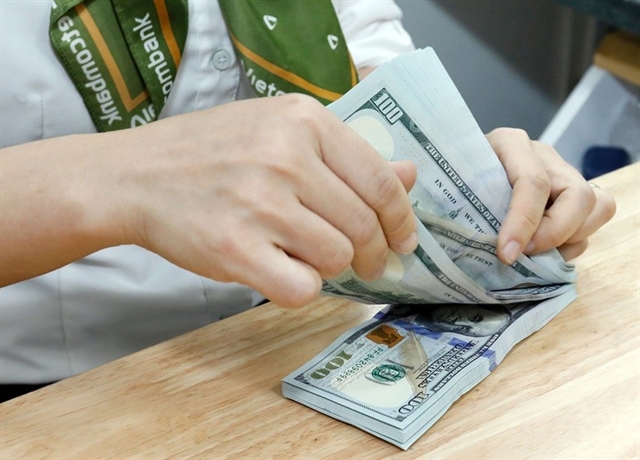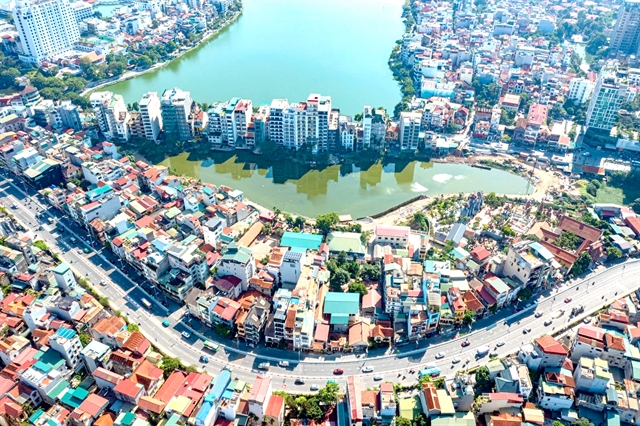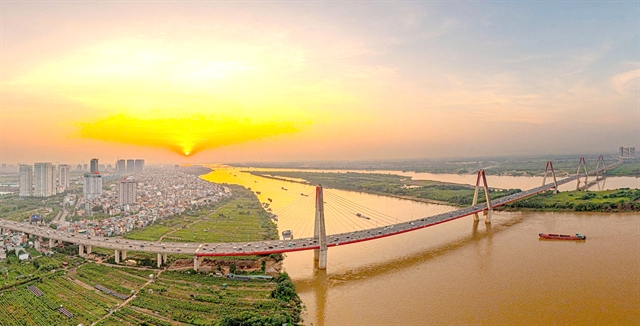 Society
Society

 |
| A section of Âu Cơ - Nghi Tàm roads in Tây Hồ District is seen from above.—VNA/VNS Photo Tuấn Anh |
HÀ NỘI — Hà Nội stands on the cusp of significant opportunities to evolve into a 'civilised, cultured and modern' capital, characterised by a high standard of living and quality of life, seventy years after its liberation.
Its economy, culture and society are expected to develop comprehensively, showcasing distinctive and harmonious features that represent the nation, while achieving a level of development comparable to that of capitals in the region and across the globe.
That was emphasised by Bùi Thị Minh Hoài, member of the Politburo and Secretary of the city’s Party Committee, during a speech at the conference commemorating the 70th anniversary of the capital's liberation (October 10, 1954 - October 10, 2024).
In Resolution No 15 issued in 2022, outlining the direction and tasks for the development of Hà Nội until 2030, with a vision towards 2045, the Politburo identified the Hồng (Red) River as a central green axis, enhancing the urban landscape along both banks.
Plans include developing urban models in the northern areas of Đông Anh, Mê Linh and Sóc Sơn districts and the western regions of Hòa Lạc and Xuân Mai.
Additionally, there is a commitment to creating a smart city based on the development of the areas along the Nhật Tân - Nội Bài corridor, focusing on urban planning, investment in construction and stabilising residency along the banks of both the Hồng (Red) and Đuống rivers.
The spatial planning also aims to incorporate underground urban spaces, green areas and public spaces.
The strategic orientations present an opportunity for the capital to concentrate its resources towards development, reflecting a vision and aspiration to construct a civilised, cultured and modern capital.
According to Hoài, the resolution serves as a new manifesto for the capital’s development in the new era.
The recently passed Capital Law 2024, which operationalises the Resolution, allows the capital to adopt specific, superior mechanisms and policies in its governance structure, decentralisation, resource mobilisation and the attraction and utilisation of talent and high-quality human resources.
Moreover, the capital's planning for the period 2021-30, with a vision towards 2050 and the adjustment plan for the capital's general planning until 2045, looking towards 2065, were reported to the Politburo and the National Assembly, awaiting approval from the Prime Minister. That will pave the way for new development spaces of the capital city.
Vice President of the Việt Nam Urban Development Planning Association and former Director of the city’s Planning and Investment Department, Đào Ngọc Nghiêm, told Thanh Niên (Young People) newspaper that the planning frameworks as essential centres that would significantly guide the city’s future growth.
Red River miracle
In pursuit of the goal to develop a 'civilised, cultured and modern' capital, Hoài stressed the need to synchronously implement a series of key tasks.
The tasks ranged from environmental protection and landscape enhancement to urban and rural development, alongside economic progress.
She highlighted the imperative to address air and water pollution comprehensively, eliminate local flooding, treat wastewater and revitalise river systems and create a distinctive environmental landscape for the capital, with the Red River as a central visual axis for cultural, commercial, service and tourism development.
The tasks also included enhancing public transport, completing the urban railway system, ring roads and bridges across the Red River by 2035, while effectively addressing congestion at urban gateways and within the city centre.
Regarding the economy, she said it needed restructuring to align with a growth model driven by science, technology and innovation.
There should be a focus on developing a digital and green economy and a circular and sharing economy, aiming for industrialisation and modernisation to be completed by 2030.
Prioritising the semiconductor industry, artificial intelligence, digital technology and emerging sectors was also crucial.
In terms of cultural and social development, as well as science and technology, she underscored the importance of creating distinctive cultural spaces that promoted the development of the cultural and creative industries.
That required exceptional mechanisms and policies for attracting, using and rewarding talent, especially high-level experts, inventors and creators, both domestically and internationally to live and work in the capital.
 |
| Nhật Tân Bridge – a unique symbol of Hà Nội.—VNA/VNS Photo Tuấn Anh |
Exceptional efforts
However, to turn the plans into a reality that defines the future of Hà Nội as a 'Red River miracle' exceptional efforts are necessary.
Stressing the role of institutional reform as a pivotal solution for the capital development, Trần Đình Thiên, former president of Việt Nam Institute of Economics, suggested that rather than merely seeking special mechanisms, the city should pursue institutional reform.
He said that the city should propose mechanisms that encourage creative talent and attract high-level investments through unconventional solutions.
"The mechanism of asking and giving resources can stifle opportunities for motivation,” he said.
A breakthrough approach was essential to propose superior, even unconventional mechanisms.
“Without this, it will be challenging to envisage how Hà Nội can leverage its millennium-old cultural heritage within a modern context," he added.
Hà Nội must realise its newly institutionalised expanded rights, as outlined in the capital law.
He said that the capital law established significant strides in decentralisation and empowering the capital administration, providing creative autonomy to its citizens and developmental stakeholders.
"However, the realisation of the advancements, even if institutionalised, requires new conditions and capacities," he concluded.
President of the Việt Nam Urban Development Planning Association, Architect Trần Ngọc Chính, said the approved planning of the Red River urban area would expedite the capital's comprehensive and sustainable development, especially as many central districts faced land scarcity for social welfare projects.
"Therefore, breakthrough and effective solutions are needed to expedite the development of spaces, particularly in utilising riverbank land and mid-river areas for tourism services and recreational parks, so that the Red River must become the Red River miracle of Hà Nội,” he said.
Not all roses
In her remarks, Hoài also acknowledged that the city also faced numerous challenges in economic development and urban management.
The challenges include unstable and unsustainable growth, urban development issues arising from rapid urbanisation, tensions between conservation and development, particularly in the old quarter and historical urban areas, infrastructural overload, widening wealth disparities and complex issues of public health and food safety and hygiene.
The challenges must be addressed promptly to achieve the goal of a civilised, cultured, and modern city, she said.
Nghiêm pointed out that since the administrative boundaries were expanded in 2008, many developmental directives were proposed, however, several remained unfulfilled.
A significant existing issue was the infrastructure system, which was critical for the capital's development but was not effectively managed due to various factors.
Additionally, the urban cluster model, which included a central city, satellite towns and ecological clusters, had yet to be realised, failing to generate the appeal of satellite towns that alleviated pressure on the city centre.
Thiên, said that Hà Nội had not fully harnessed its substantial developmental potential over the past time.
“As a locality with unique characteristics and a distinctive mission, the capital has yet to be granted its appropriate powers,” he said.
The limitation resulted in a lack of clear and comprehensive creative space in implementing strategies and developmental plans.
"It is fundamentally similar to other localities across the nation, the mechanisms of asking and giving still dominate the allocation of resources and management of the capital’s development," he said.
With the spirit of launching a new developmental trajectory, the Capital Law and the Hà Nội planning for the period 2021-30, with a vision towards 2050, encompassed many solutions to transcend the aforementioned institutional challenges.
"However, this is only the beginning. The challenges of implementation have yet to fully manifest, while the demands for breakthroughs and institutional refinement from a decentralised and empowered perspective to meet modern developmental needs remain exceedingly high," he said. — VNS




